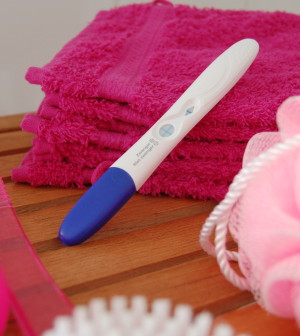- Skip Storing This Everyday Product in the Fridge Door
- Green Tea + B3 Pairing May Boost Brain Health
- Navigating Your Midlife Crisis: Embracing New Possibilities
- City Raccoons Showing Signs of Domestication
- Mapping the Exposome: Science Broadens Focus to Environmental Disease Triggers
- One Week Less on Social Media Linked to Better Mental Health
- Your Brain Changes in Stages as You Age, Study Finds
- Some Suicide Victims Show No Typical Warning Signs, Study Finds
- ByHeart Formula Faces Lawsuits After Babies Sickened With Botulism
- Switch to Vegan Diet Could Cut Your Greenhouse Gas Emissions in Half
Texas Infant Dies of Legionnaires’ Disease After ‘Water Birth’


A new report on a Texas infant who died from Legionnaires’ disease after being born in a whirlpool tub highlights the potential dangers of having a “water birth.”
It’s not clear if the baby was infected with the respiratory illness via the well water in the tub where the infant was born, according to the report. Still, Texas health officials have since warned midwives statewide about the risks of water birth.
“The risk of infection varies depending on the stage of labor in which water birth is utilized but any process or procedure that has the potential to introduce a microorganism into a person poses a serious risk for infection or disease,” said report author Elyse Fritschel, an epidemiologist with the Texas Department of State Health Services. “Health care providers should do everything they can to ensure conditions that reduce or eliminate the risk of infection.”
One expert said that water births are very rare in the United States, with an estimated 4,000 of the 4 million annual births taking place this way.
“Some of these water births occur at the family’s home, either in their own bathtub or in a rental-type tub,” said Michelle Collins, director of the Nurse-Midwifery Program at Vanderbilt University School of Nursing, in Nashville, Tenn. “Others occur in birth centers and hospitals in tubs made especially for repeated patient use wherein strict cleaning protocols are set in place.”
Advocates of water birth say it leads to a less painful and more relaxing birth. But critics warn about the increased risk of infection.
In a joint statement earlier this year, the American College of Obstetricians and Gynecologists and the American Academy of Pediatrics expressed skepticism about water birth: “Undergoing the early stages of labor in a birthing pool may offer some advantages to pregnant women. However, underwater delivery has no proven benefit to women or babies and may even pose a risk of serious health problems for the newborn.”
The Texas baby, whose gender was not disclosed, appeared at a hospital in January 2014 with symptoms including loose feces and respiratory failure. The infant, who was born in a whirlpool-style tub full of well water that hadn’t been chemically disinfected, died after 19 days in the hospital of Legionnaires’ disease.
The illness, named after a 1976 American Legion conference in Philadelphia where dozens of attendees were infected, is a type of pneumonia. It is “transmitted by breathing in small droplets of water containing the bacteria,” Fritschel explained, “so the child may have aspirated or breathed in very small amounts of water containing the bacteria during or after birth.”
Newborns are especially vulnerable to infection with this illness because their immune systems and lungs are still developing, she said.
“Respiratory infections are a major cause of illness, hospitalizations and mortality in infants worldwide,” Fritschel said.
The researchers weren’t able to confirm that the water caused the infant to become ill because the tub used during the baby’s birth had been cleaned and stored. Well water samples tested negative for the bacteria that causes Legionnaire’s disease.
Fritschel didn’t advise against water births in general, but recommended an intense focus on safety.
“Women should work with their health care provider to ensure procedures and processes are in place to prevent infection by avoiding birthing tubs that have circulating water and heating elements — whirlpool-style tubs — as these tubs may be difficult to clean and raise the temperature of the water, which may be conducive to the growth of microorganisms,” she said.
“Prefilling of a tub days or up to hours prior to labor should be avoided,” she added, “as this increases the likelihood of growth of microorganisms and raises the risk of infection.”
In addition, she said, women should consider immersing themselves in water only during the first part of labor, and not during delivery.
Collins agreed about the importance of infection control in water births. While water births have “significant benefits,” dangerous types of bacteria can thrive in water, she said.
“To protect mothers and their newborns, particular attention to appropriate cleaning techniques is not optional,” she said. “It is an imperative.”
The report of the infant’s death appears in the January 2015 issue of Emerging Infectious Diseases.
More information
For more about the pros and cons of water birth, try the American Pregnancy Association.
Source: HealthDay
Copyright © 2025 HealthDay. All rights reserved.










